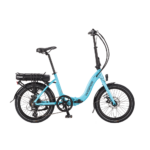Belts v Chains
- Thread starter pushmepullu
- Start date
Dare I ask why?
My car cambelt is good for 4 years / 60,000 miles and gets wet & dusty
My simple logic finds a belt drive combined with my hub gears a possible low maintenance option.
What am I missing?
All the best
Bob_about
My car cambelt is good for 4 years / 60,000 miles and gets wet & dusty
My simple logic finds a belt drive combined with my hub gears a possible low maintenance option.
What am I missing?
All the best
Bob_about
This has come up before. I like the idea of a belt as chain maintenance is a right pain - not a goer in terms of efficiency though.
More info here...
http://www.pedelecs.co.uk/forum/electric-bicycles/4970-cytronex-cannondale-super-six-ultegra-4.html?highlight=toothed+belt
More info here...
http://www.pedelecs.co.uk/forum/electric-bicycles/4970-cytronex-cannondale-super-six-ultegra-4.html?highlight=toothed+belt
The info is within that link that Harry has given, my answer being hereDare I ask why?
Great for low maintenance though, there's even some Harley Davidsons using them instead of chains.
.
Interesting you say about it being less efficient than a chain, I really thought it was the future. My friend told me about some person doing a world tour and it was with a belt driven bike due to the durability and low maintenance. Also Rohloff have apparently sanctioned a belt drive option. The only issue is that the frame needs to be splitable. With electric drives I would have thought it wouldn't matter too much.
It's not just Harley D that have motorbikes with belt drives, so do BMW.
It's not just Harley D that have motorbikes with belt drives, so do BMW.
And so did Kawasaki at one point - on one of their mid-weight models (a 305cc bike if memory serves).Interesting you say about it being less efficient than a chain, I really thought it was the future. My friend told me about some person doing a world tour and it was with a belt driven bike due to the durability and low maintenance. Also Rohloff have apparently sanctioned a belt drive option. The only issue is that the frame needs to be splitable. With electric drives I would have thought it wouldn't matter too much.
It's not just Harley D that have motorbikes with belt drives, so do BMW.
It's generally considered that a well-maintained chain is the most efficient drive though. I can see why - in anything which has to flex (round the sprockets) you invariably get heat generated. You also need a certain minimum pulley size which on a bicycle is likely to result in a larger rear sprocket and therefore a much larger front (pedal) drive wheel unless you have special arrangements within the hub gear (i.e. higher ratios than usual).
Helical gears (as in a shaft drive) are even worse in terms of power transfer efficiency.
Rog.
They all seem to be fitted to sedate motorbikes though, probably bought by people not worried about high efficiency. Shaft drives are another unpopular alternative that is favoured by BMW, less maintenance but less efficient with expensive repairs. Some things BMW do are good like the telelever forks but they are unpopular because they don't feel right.Interesting you say about it being less efficient than a chain, I really thought it was the future. My friend told me about some person doing a world tour and it was with a belt driven bike due to the durability and low maintenance. Also Rohloff have apparently sanctioned a belt drive option. The only issue is that the frame needs to be splitable. With electric drives I would have thought it wouldn't matter too much.
It's not just Harley D that have motorbikes with belt drives, so do BMW.
A chain can easily be adjusted for length which is pretty important on an ebike as a standard chain isn't long enough for my Wisper, if I had to buy a proprietary belt then I can be sure it would cost quite a bit more than two budget chains connected up.
Plus belts just look a bit girly and weedy, I want metal!
Thanks to Harry & Flecc for links - note to self, try hitting search before reply now and again!The info is within that link that Harry has given, my answer being here
Great for low maintenance though, there's even some Harley Davidsons using them instead of chains.
.
I can understand the depth of a toothed belt giving rise to the stretch & compression soaking up energy and along with the friction creating heat.
This kinda suggests that a belt with as thin & flat a profile as possible (with a tensioner arm) would be more suitable so lomg as it didnt slip
Im sure I saw a prototype bike with a number of inovations recently which included a fully encased belt drive which along with the rear mudguard supported the rear wheel o cannot recall where I saw it now - it was a variation on the classic dutch style bike - the handlebars also could be turned and locked as a security feature - if I find the info Ill post a link.
The point being the belt it was using would have been pretty flat to fit within the casing and make the comparitively sharp changes in direction. It certainly would not have been a tradditional toothed v belt.
So, perhaps there is more belt based innovation just around the corner?
In the mean time Ill carry on wiping all the dirty oil, grit and muck off my chain, crank & sprocket every week and replacing it with fresh for Monday morning - tiresome but I know it makes sense!
So - what about an encased chain drive - or should I have hit search before I said that?!
All the best
Bob_about
That used to be quite common on traditional 'boneshakers' but dropped out of fashion. They were inclined to be heavy, inconvenient to gain access for lubrication (they enclosed the chain but were never intended to be oil-tight) and worst of all they tended to clang and scrape as you pedalled....So - what about an encased chain drive - or should I have hit search before I said that?!
I think I've seen a properly sealed full enclosure which included some sort of oil bath - but I suspect the weight and added complexity made sure they never became popular.
Rog.
The whole story Bob.
So why do cars use these toothed belts if they are inefficient?
Well, first of all, the engines designed for ultimate performance on cars and motorcycles don't used them, they use chain or gear camshaft drive for maximum efficiency.
On production cars there are several good reasons to use them, the last one a clincher:
1) They are cheaper than internal gear and chain drives.
2) They avoid the need for a lubrication system for gears or chains.
3) Unlike a chain, they don't need the complexity of a tensioner ever since their cordage is non-stretch.
4) Road cars with chain or gear drive to the camshaft have to have a V belt drive in addition for the alternator, but since the toothed belt can be pressed into service for that as well, the efficency loss of the V belt is removed. Since that is also substantial, the loss of the toothed belt is offset. So is the need for a V belt tensioner.
.
These belts were highly developed and as flat and thin as they could be in the early 1960s Bob, and I worked with them for several years in that decade. The only useful changes since then have been to the internal cordage, at first non-stretchable synthetic fibers and later both steel and composite fibres like carbon used. These only have an effect on life, not on effciency.This kinda suggests that a belt with as thin & flat a profile as possible (with a tensioner arm) would be more suitable so lomg as it didnt slip
Already seen in the forum and the belt innovations claimed were spurious. It was just differently profiled in the teeth, not more efficient.Im sure I saw a prototype bike with a number of inovations recently which included a fully encased belt drive which along with the rear mudguard supported the rear wheel o cannot recall where I saw it now - it was a variation on the classic dutch style bike - the handlebars also could be turned and locked as a security feature - if I find the info Ill post a link.
Rather like gear teeth profiles, the design ultimates were reached long ago. Any possible gain now, such as in material surface friction, could only give a miniscule gain. Remember, a chain in good condition is very close to 100% efficient, so how could anyone gain anything appreciably on that?So, perhaps there is more belt based innovation just around the corner?
Sunbeam made bicycles with their famous oilbath chaincase back in the 1920s, '30s and beyond, and those could make the chain and sprockets last as long as the bike since the chain dipped in oil every pass and was always completely free of grit etc. Of course getting a bike's rear wheel out was a different matter! We used to use frame stretchers to exand the rear frame on the nearside enough to pass in new tyres or tubes past the l/h spindle. Fine with the springy steel frames of those days, but dangerous with alloy frames.So - what about an encased chain drive
So why do cars use these toothed belts if they are inefficient?
Well, first of all, the engines designed for ultimate performance on cars and motorcycles don't used them, they use chain or gear camshaft drive for maximum efficiency.
On production cars there are several good reasons to use them, the last one a clincher:
1) They are cheaper than internal gear and chain drives.
2) They avoid the need for a lubrication system for gears or chains.
3) Unlike a chain, they don't need the complexity of a tensioner ever since their cordage is non-stretch.
4) Road cars with chain or gear drive to the camshaft have to have a V belt drive in addition for the alternator, but since the toothed belt can be pressed into service for that as well, the efficency loss of the V belt is removed. Since that is also substantial, the loss of the toothed belt is offset. So is the need for a V belt tensioner.
.
There is a move back to chains in cars anyway, mainly because they offer better precision in valve timing - essential in todays engines. Also cost cutting resulted in loads of plastic in the cambelt's drive chain (there is still a tensioner and the belt quite often drives the waterpump) and have proved unreliable if not changed regularly - personally I would favour a duplex chain over a rubber belt any day.
Ditto. It avoids the need for changing the belt every 40,000 or so miles, but of course that belt change isn't a manufacturing cost and helps support dealers in these low maintenance need days.personally I would favour a duplex chain over a rubber belt any day.
.
Now I think about it, my old Morris Minor van had a timing chain rather than a cam belt.
That was a performance motor!
Happy days
I'll get my coat
Bob_about
That was a performance motor!
Happy days
I'll get my coat
Bob_about
Another Perspective on Belt Drives vs. Chain Drives
I'd like to re-examine the discussion of bel drives vs. chain drives.
While I understand that in this thread, Flecc noted that belts are less efficient than chain drives, the jury still seems to be out on just how efficient/inefficient the newest carbon, toothed belt drives are. The Gates Corporation says that their belts can match the efficiency of chains. However, I haven't seen any scientific tests assessing a belt drive's efficiency compared with a chain. Regardlesss, there's plenty of discusssion amongst regular cyclists, motorcyclists, and others regarding the merits of belts versus chains. See, for example:
Myth: Belt drive has poor efficiency
http://en.wikipedia.org/wiki/Belt_(mechanical)
BELT OR CHAIN?
I also haven't located hard figures about what the varying efficiencies mean. For example, if a toothed, belted drive is 10 percent less efficient in transferring pedal power to gears, what does that mean in practical terms--how many more minutes to go 10 miles, for example?
More significantly, there are other ways to look at efficiency. If one considers the total amount of time spent keeping a bike maintained for regular use, this might be a more accurate measure of the total efficiency of biking. I noted that another forum member, c_elder, says that he spends 45 minutes a week just on chain maintenance. That time spent trying to keep a chain in proper working order translates into a fairly inefficient system!
Further, even if chains are more efficient, efficiency isn't the only thing that cyclists worry about. How about:
1. Trying to clean mud and grit-clogged chains?
2. Derailleaur adjustments (if you don't have an internally-geared hub--required for belt drives)?
3. Cleaning oily grime from your frame, hands, and pants/calves?
4. Annoying clanking and squealing from mal-adjusted or rusty chains?
I think that one of the greatest disincentives to cycling in general is the maintainence and grime that are associated with chain-driven bikes. Having a belt-driven bike, with an internally-geared hub, and sealed bearings can bring one as close as possible to a maintenance-free bike. More riding and less maintaining translates into greater overall efficiency. And making the bike an e-bike will help the human rider overcome any inefficiencies in the belt drive system.
I'm the happy owner of a Kalkhoff Pro Connect S, but I would switch in a heartbeat to an e-bike powered with a belt drive. Just waiting for an e-bike maker to put 2 and 2 together and mate a belt drive/internal hub with a electric drive system.
I'd like to re-examine the discussion of bel drives vs. chain drives.
While I understand that in this thread, Flecc noted that belts are less efficient than chain drives, the jury still seems to be out on just how efficient/inefficient the newest carbon, toothed belt drives are. The Gates Corporation says that their belts can match the efficiency of chains. However, I haven't seen any scientific tests assessing a belt drive's efficiency compared with a chain. Regardlesss, there's plenty of discusssion amongst regular cyclists, motorcyclists, and others regarding the merits of belts versus chains. See, for example:
Myth: Belt drive has poor efficiency
http://en.wikipedia.org/wiki/Belt_(mechanical)
BELT OR CHAIN?
I also haven't located hard figures about what the varying efficiencies mean. For example, if a toothed, belted drive is 10 percent less efficient in transferring pedal power to gears, what does that mean in practical terms--how many more minutes to go 10 miles, for example?
More significantly, there are other ways to look at efficiency. If one considers the total amount of time spent keeping a bike maintained for regular use, this might be a more accurate measure of the total efficiency of biking. I noted that another forum member, c_elder, says that he spends 45 minutes a week just on chain maintenance. That time spent trying to keep a chain in proper working order translates into a fairly inefficient system!
Further, even if chains are more efficient, efficiency isn't the only thing that cyclists worry about. How about:
1. Trying to clean mud and grit-clogged chains?
2. Derailleaur adjustments (if you don't have an internally-geared hub--required for belt drives)?
3. Cleaning oily grime from your frame, hands, and pants/calves?
4. Annoying clanking and squealing from mal-adjusted or rusty chains?
I think that one of the greatest disincentives to cycling in general is the maintainence and grime that are associated with chain-driven bikes. Having a belt-driven bike, with an internally-geared hub, and sealed bearings can bring one as close as possible to a maintenance-free bike. More riding and less maintaining translates into greater overall efficiency. And making the bike an e-bike will help the human rider overcome any inefficiencies in the belt drive system.
I'm the happy owner of a Kalkhoff Pro Connect S, but I would switch in a heartbeat to an e-bike powered with a belt drive. Just waiting for an e-bike maker to put 2 and 2 together and mate a belt drive/internal hub with a electric drive system.
I certainly agree with the all-aspects view Edward, my argument was a purist one on efficiency only where a toothed belt cannot match a chain. Chain maintenance is a real pain and for utility cycling purposes a high quality belt drive is far more convenient and much longer lived.
Belts are a good option wherever lubrication difficulties exist, and they've been extensively used in printers and copiers for this reason.
I'm mainly not happy with having them on unpowered bicycles or low powered e-bikes where every personal watt is precious, but on higher powered e-bikes they could well be justified on the grounds of sheer convenience. They are especially suitable for single rear strut bikes like the Burrows 8-freight, with an open side wheel on one side and the drive train the other. This type means tyre, tube and belt changes without any dismantling.

Belts are a good option wherever lubrication difficulties exist, and they've been extensively used in printers and copiers for this reason.
I'm mainly not happy with having them on unpowered bicycles or low powered e-bikes where every personal watt is precious, but on higher powered e-bikes they could well be justified on the grounds of sheer convenience. They are especially suitable for single rear strut bikes like the Burrows 8-freight, with an open side wheel on one side and the drive train the other. This type means tyre, tube and belt changes without any dismantling.

Thanks for the clarification, Flecc. I am just hoping that belt drives will not be ignored by pedelec manufacturers. I think having low-maintanence pedelecs will only broaden their appeal to a wider populace . . . and bring down their cost for all of us. Also, as someone who lives in a developing country with frame-breaking roads and absolutely no quality parts or bike tools (headset wrenches here are pipe wrenches!), I have a particular interest in low-maintenance products!
Related Articles
-
 MTF Enterprises announces acquisition of EMU Electric Bikes
MTF Enterprises announces acquisition of EMU Electric Bikes- Started by: Pedelecs
-
 Wisper 806T folding bike wins Which? ‘Best Buy’
Wisper 806T folding bike wins Which? ‘Best Buy’- Started by: Pedelecs
-
 Sustrans calls for protected cycle lanes
Sustrans calls for protected cycle lanes- Started by: Pedelecs
-
 Amazon launch their first UK e-cargo micromobility hub
Amazon launch their first UK e-cargo micromobility hub- Started by: Pedelecs


